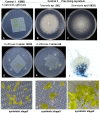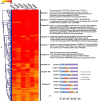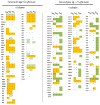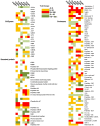Comparative Transcriptomics Analysis of the Symbiotic Germination of D. officinale (Orchidaceae) With Emphasis on Plant Cell Wall Modification and Cell Wall-Degrading Enzymes
- PMID: 35599894
- PMCID: PMC9120867
- DOI: 10.3389/fpls.2022.880600
Comparative Transcriptomics Analysis of the Symbiotic Germination of D. officinale (Orchidaceae) With Emphasis on Plant Cell Wall Modification and Cell Wall-Degrading Enzymes
Abstract
Orchid seed germination in nature is an extremely complex physiological and ecological process involving seed development and mutualistic interactions with a restricted range of compatible mycorrhizal fungi. The impact of the fungal species' partner on the orchids' transcriptomic and metabolic response is still unknown. In this study, we performed a comparative transcriptomic analysis between symbiotic and asymbiotic germination at three developmental stages based on two distinct fungi (Tulasnella sp. and Serendipita sp.) inoculated to the same host plant, Dendrobium officinale. Differentially expressed genes (DEGs) encoding important structural proteins of the host plant cell wall were identified, such as epidermis-specific secreted glycoprotein, proline-rich receptor-like protein, and leucine-rich repeat (LRR) extensin-like protein. These DEGs were significantly upregulated in the symbiotic germination stages and especially in the protocorm stage (stage 3) and seedling stage (stage 4). Differentially expressed carbohydrate-active enzymes (CAZymes) in symbiotic fungal mycelium were observed, they represented 66 out of the 266 and 99 out of the 270 CAZymes annotated in Tulasnella sp. and Serendipita sp., respectively. These genes were speculated to be involved in the reduction of plant immune response, successful colonization by fungi, or recognition of mycorrhizal fungi during symbiotic germination of orchid seed. Our study provides important data to further explore the molecular mechanism of symbiotic germination and orchid mycorrhiza and contribute to a better understanding of orchid seed biology.
Keywords: CAZymes; Serendipita sp.; Tulasnella sp.; comparative transcriptome; symbiotic germination.
Copyright © 2022 Chen, Tang, Kohler, Lebreton, Xing, Zhou, Li, Martin and Guo.
Conflict of interest statement
The authors declare that the research was conducted in the absence of any commercial or financial relationships that could be construed as a potential conflict of interest.
Figures







Similar articles
-
Functional Insights into the Roles of Hormones in the Dendrobium officinale-Tulasnella sp. Germinated Seed Symbiotic Association.Int J Mol Sci. 2018 Nov 6;19(11):3484. doi: 10.3390/ijms19113484. Int J Mol Sci. 2018. PMID: 30404159 Free PMC article.
-
What role does the seed coat play during symbiotic seed germination in orchids: an experimental approach with Dendrobium officinale.BMC Plant Biol. 2022 Jul 29;22(1):375. doi: 10.1186/s12870-022-03760-0. BMC Plant Biol. 2022. PMID: 35906552 Free PMC article.
-
iTRAQ and RNA-Seq Analyses Provide New Insights into Regulation Mechanism of Symbiotic Germination of Dendrobium officinale Seeds (Orchidaceae).J Proteome Res. 2017 Jun 2;16(6):2174-2187. doi: 10.1021/acs.jproteome.6b00999. Epub 2017 May 17. J Proteome Res. 2017. PMID: 28488443
-
Germination and seedling establishment in orchids: a complex of requirements.Ann Bot. 2015 Sep;116(3):391-402. doi: 10.1093/aob/mcv087. Epub 2015 Aug 12. Ann Bot. 2015. PMID: 26271118 Free PMC article. Review.
-
In Vitro Symbiotic Germination: A Revitalized Heuristic Approach for Orchid Species Conservation.Plants (Basel). 2020 Dec 9;9(12):1742. doi: 10.3390/plants9121742. Plants (Basel). 2020. PMID: 33317200 Free PMC article. Review.
Cited by
-
Improving plant salt tolerance through Algoriphagus halophytocola sp. nov., isolated from the halophyte Salicornia europaea.Front Microbiol. 2024 Oct 21;15:1466733. doi: 10.3389/fmicb.2024.1466733. eCollection 2024. Front Microbiol. 2024. PMID: 39498140 Free PMC article.
-
Integration of fungal transcriptomics and metabolomics provides insights into the early interaction between the ORM fungus Tulasnella sp. and the orchid Serapias vomeracea seeds.IMA Fungus. 2024 Oct 25;15(1):31. doi: 10.1186/s43008-024-00165-6. IMA Fungus. 2024. PMID: 39456087 Free PMC article.
-
Mycorrhizal fungus BJ1, a new species of Tulasnella sp.: its biological characteristics and promoting effect on seed germination of Bletilla striata.Front Plant Sci. 2025 Feb 21;16:1542585. doi: 10.3389/fpls.2025.1542585. eCollection 2025. Front Plant Sci. 2025. PMID: 40061032 Free PMC article.
-
Discordance Down Under: Combining Phylogenomics and Fungal Symbioses to Detangle Difficult Nodes in a Diverse Tribe of Australian Terrestrial Orchids.Syst Biol. 2025 Jun 12;74(3):434-452. doi: 10.1093/sysbio/syae070. Syst Biol. 2025. PMID: 39657584 Free PMC article.
-
Perspective and challenges of mycorrhizal symbiosis in orchid medicinal plants.Chin Herb Med. 2024 Mar 8;16(2):172-179. doi: 10.1016/j.chmed.2024.03.001. eCollection 2024 Apr. Chin Herb Med. 2024. PMID: 38706832 Free PMC article. Review.
References
LinkOut - more resources
Full Text Sources

